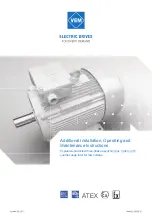
N40475
Chapter 3
Page 7
Propeller shafts and couplings
Propeller shafts
It is recommended that all engines are mounted on flexible
mountings (1), which will reduce noise and vibration,
and will prevent hull movements resulting in forces being
applied to the engine.
The responsibility for the design and installation of the
transmission system connected to the gearbox lies with
the boat designer, the boat builder, the naval architect or
the engine installer. It is recommended that a Torsional
Vibration Analysis (TVA) is carried out on the complete
drive system. Mass Elastic Data can be provided on request
from Wimborne Marine Power Centre.
Figure 1 shows a simple arrangement, where the propeller
shaft is supported only by the gearbox coupling and an
outboard rubber bearing at the propeller end. Entry of water
into the boat is prevented by a shaft seal, which must be
flexibly mounted to allow for engine movement. A flexible
shaft coupling (2) is fitted to the gearbox coupling, to allow
momentary angular misalignment in operation.
This system is only suitable for applications where the
speed, diameter, and unsupported length of the propeller
shaft will not induce ‘whirling’ (i.e. the centrifugal force
generated by the speed of rotation is not sufficient to bend
the shaft into a bow shape).
Figure 1 also shows a cutless bearing (3), flexibly mounted
shaft seals (4), reinforced rubber hose (5), graphited
asbestos string (6), stuffing box (7) and the drive shaft (8).
Where the propeller shaft length is such that it cannot be
simply supported by the gearbox coupling and ‘P’ bracket,
without the risk of whirling, the arrangement shown in figure
2 may be adopted.
Water supply (4) for bearings (use hose from M14 x 1.5
tapping on heat exchanger end cap). End cap with tapping
is optional.
In this case one or more additional bearings (3) are included
in the shaft log, and flexible shaft couplings (2) (which will
accept thrust) are used to permit the engine to move on the
flexible mountings (1) .
Warning!
Use a syphon break (5) where a water lift exhaust
system is specified.
A variation of this is to use a thrust block (bearing) at the
point where the shaft emerges from the log into the engine
room, together with constant velocity joints at each end of
the short shaft connected to the gearbox coupling.
Figure 1
Figure 2
Содержание M190C
Страница 1: ...Installation Manual Part No N40475 GB Marine Power M300C M250C M216C M190C ...
Страница 2: ......
Страница 6: ......
Страница 10: ...Contents N40475 ...
Страница 18: ...Chapter 3 N40475 Page 8 ...
Страница 24: ...Chapter 4 N40475 Page 14 ...
Страница 26: ...Chapter 5 N40475 Page 16 ...
Страница 55: ...N40475 Chapter 8 Page 45 Engine wiring harness overview ...
Страница 56: ...Chapter 8 N40475 Page 46 Panel harness overview ...
Страница 57: ...N40475 Chapter 8 Page 47 Wiring diagrams Engine wiring harness 1 ...
Страница 58: ...Chapter 8 N40475 Page 48 Engine wiring harness 2 ...
Страница 59: ...N40475 Chapter 8 Page 49 Engine panels 1 ...
Страница 60: ...Chapter 8 N40475 Page 50 Interconnecting leads 1 ...
Страница 61: ...N40475 Chapter 8 Page 51 Master slave option port ...
Страница 62: ...Chapter 8 N40475 Page 52 Marine junction box ...
Страница 63: ...N40475 Chapter 8 Page 53 Master slave option starboard ...
Страница 64: ...Chapter 8 N40475 Page 54 Interconnecting leads 2 ...
Страница 65: ...N40475 Chapter 8 Page 55 Engine panels 2 ...
Страница 66: ...Chapter 8 N40475 Page 56 ...
Страница 68: ...Chapter 9 N40475 Page 58 ...
Страница 72: ...Chapter 11 N40475 Page 62 ...
Страница 76: ...Chapter 12 N40475 Page 66 ...
Страница 80: ...Chapter 12 N40475 Page 70 ...
















































